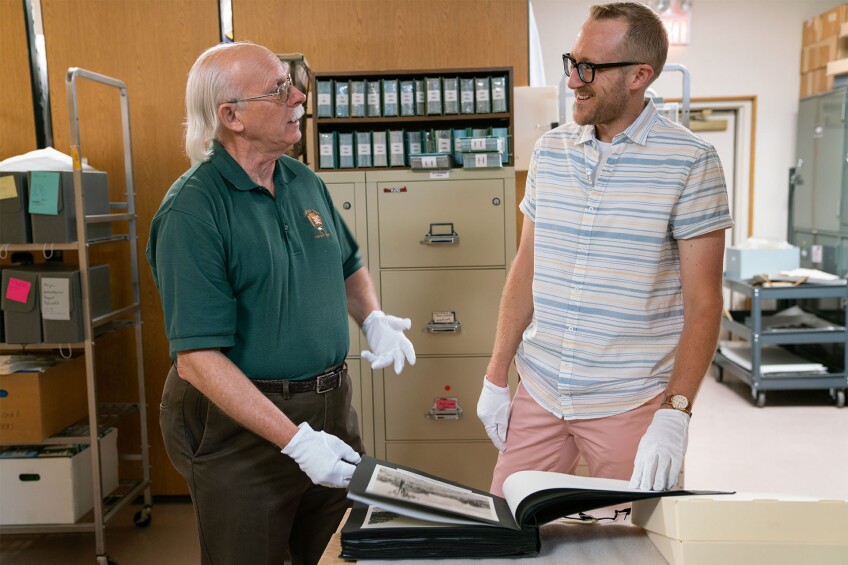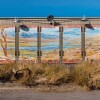Lost LA Field Notes: Desert Fantasy

Union Bank is a proud sponsor of Lost LA. 
As someone who grew up with a healthy appreciation for desert landscapes, I’m often puzzled at how earlier generations of Californians once dismissed their deserts as static, worthless places — a “nakedness of sand and gravel,” to quote early American explorer John C. Fremont. In truth, our deserts offer remarkable variety. Indeed, scientists recognize three separate deserts within California’s borders, each one distinguished by its growth varieties. There’s the cold Great Basin, the land of sagebrush; the hot Mojave, home to the Joshua tree; and the scorching Colorado, marked by the creosote bush. The variety of human landscapes, from Palm Springs and Manzanar to Slab City, is no less staggering.
The old idea that deserts should be avoided, or, at best, transformed into something else, survives today. Witness the rush over the past decade to fill any desert expanse with solar power plants and wind farms. But Californians have generally learned to love their arid eastern lands. Joshua Tree National Park continues to enjoy (or suffer from, depending on your perspective) record visitation. Music and art festivals draw hundreds of thousands more. And of course, for many Californians, the desert is home.
Meeting Kim Stringfellow
How did Californians change their mind about the desert? In many ways, we have passionate desert advocates like the artist and author Kim Stringfellow to thank. Kim’s work, from her 2005 book and art installation project “Greetings From the Salton Sea” to her more recent “Mojave Project,” inform and inspire us to think about arid landscapes in new ways. I was fortunate enough to chat with Kim in a wide-ranging interview that appears throughout this episode.

As I say in the show, Kim reminded me of another desert advocate: Minerva Hamilton Hoyt, whose passion for desert plants sparked the crusade that led to the creation of Joshua Tree National Monument in 1936. Hoyt, I should note, concerned herself primarily with the preservation of natural landscapes. What makes Kim’s work especially valuable is how it highlights the cultural, human elements that are as essential to California’s deserts as are cactuses, creosote bushes, and Joshua trees.
Travel Tips
- Tour Modern Palm Springs. In the short time I spent with him, tour guide and author Michael Stern expanded my thinking about Palm Springs’ architecture. When I’m in Palm Springs next, I plan to take his Modern Tour. He not only offers unparalleled access to significant houses. He also brings to his tour the knowledge of a bona fide modern architecture expert. Stern is the co-author (with Alan Hess) of “Julius Shulman: Palm Springs” (Rizzoli, 2008).
- See Bombay Beach’s Art. The Bombay Beach Biennale, an absurdist art festival, introduces an impressive roster of artists to the Salton Sea each year. Co-founder Tao Ruspoli gives a brief tour of the highlights in the episode, but art installations dot the town’s small street grid and remain open to the public long after the festival ends.
- Visit Joshua Tree in a Jeep. Though I’d visited many times, I’d only seen a fraction of Joshua Tree National Park before I got a Jeep. The park is laced with rugged roads, so a high-clearance, four-wheel-drive vehicle can open up much of the backcountry.
Essential Reading
- “Preserving the Desert: A History of Joshua Tree National Park” by Lary M. Dilsaver (University of Virginia Press, 2017)
- “Frontier of Leisure: Southern California and the Shaping of Modern America” by Lawrence Culver (Oxford University Press, 2010)
- “The Land of Little Rain” by Mary Hunter Austin (multiple editions, first released in 1903)
- “Greetings From the Salton Sea: Folly and Invention in the Southern California Landscape” by Kim Stringfellow (Center for American Places, 2011)
- “Mojave Project Reader, Vol. 1” and “Mojave Project Reader, Vol. II” by Kim Stringfellow (Kim Stringfellow Press, 2017)
The Archive

National parks are known for a different kind of preservation, but most of them also carefully protect the primary sources of history in their archives. Joshua Tree is no exception. Its archives in Twentynine Palms include administrative records and one-of-a-kind materials like the photo album — we call it a “pitch deck” in the episode — that persuaded President Franklin D. Roosevelt to create the Joshua Tree National Monument in 1936.
Ranger and historian Joseph Zarki collected many of the best photographs from the archives in his book, “Joshua Tree National Park” (Arcadia Publishing, 2015).
Top Image: Finding art in the desert | Katie Noonan















